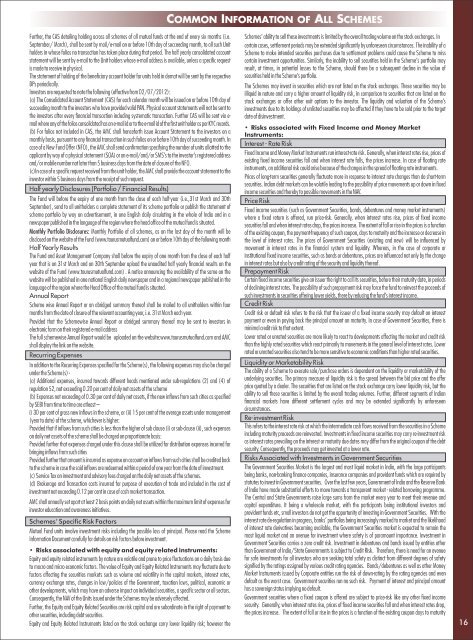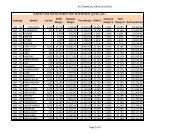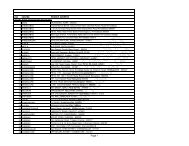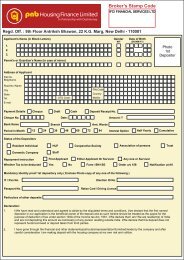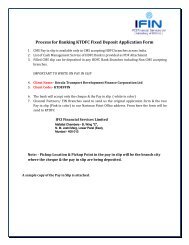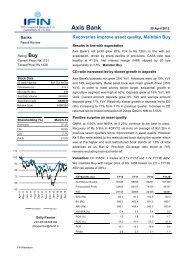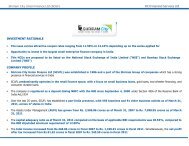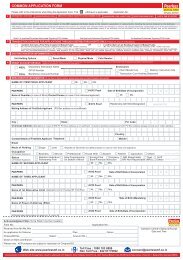Common Key Information Memorandum cum Application Form
Common Key Information Memorandum cum Application Form
Common Key Information Memorandum cum Application Form
You also want an ePaper? Increase the reach of your titles
YUMPU automatically turns print PDFs into web optimized ePapers that Google loves.
COMMON INFORMATION OF ALL SCHEMESFurther, the CAS detailing holding across all schemes of all mutual funds at the end of every six months (i.e.September/ March), shall be sent by mail/e-mail on or before 10th day of succeeding month, to all such Unitholders in whose folios no transaction has taken place during that period. The half yearly consolidated accountstatement will be sent by e-mail to the Unit holders whose e-mail address is available, unless a specific requestis made to receive in physical.The statement of holding of the beneficiary account holder for units held in demat will be sent by the respectiveDPs periodically.Investors are requested to note the following (effective from 02/07/2012):(a) The Consolidated Account Statement (CAS) for each calendar month will be issued on or before 10th day ofsucceeding month to the investors who have provided valid PAN. Physical account statements will not be sent tothe investors after every financial transaction including systematic transaction. Further CAS will be sent via e-mail where any of the folios consolidated has an e-mail id or to the e-mail id of the first unit holder as per KYC records.(b) For folios not included in CAS, the AMC shall henceforth issue Account Statement to the investors on amonthly basis, pursuant to any financial transaction in such folios on or before 10th day of succeeding month. Incase of a New Fund Offer (NFO), the AMC shall send confirmation specifying the number of units allotted to theapplicant by way of a physical statement (SOA) or an e-mail/and/or SMS's to the investor's registered addressand/or mobile number not later than 5 business days from the date of closure of the NFO.(c)In case of a specific request received from the unit holder, the AMC shall provide the account statement to theinvestor within 5 business days from the receipt of such request.Half yearly Disclosures (Portfolio / Financial Results)The Fund will before the expiry of one month from the close of each half-year (i.e.,31st March and 30thSeptember), send to all unitholders a complete statement of its scheme portfolio or publish the statement ofscheme portfolio by way on advertisement, in one English daily circulating in the whole of India and in anewspaper published in the language of the region where the head office of the mutual fund is situated.Monthly Portfolio Disclosures: Monthly Portfolio of all schemes, as on the last day of the month will bedisclosed on the website of the Fund (www.taurusmutualfund.com) on or before 10th day of the following monthHalf Yearly ResultsThe Fund and Asset Management Company shall before the expiry of one month from the close of each halfyear that is on 31st March and on 30th September upload the unaudited half yearly financial results on thewebsite of the Fund (www.taurusmutualfund.com) . A notice announcing the availability of the same on thewebsite will be published in one national English daily newspaper and in a regional newspaper published in thelanguage of the region where the Head Office of the mutual fund is situated.Annual ReportScheme wise Annual Report or an abridged summary thereof shall be mailed to all unitholders within fourmonths from the date of closure of the relevant accounting year, i.e. 31st March each year.Provided that the Schemewise Annual Report or abridged summary thereof may be sent to investors inelectronic form on their registered e-mail addressThe full schemewise Annual Report would be uploaded on the website:www.taurusmutualfund.com and AMCshall display the link on the website.Recurring ExpensesIn addition to the Recurring Expenses specified for the Scheme(s), the following expenses may also be chargedunder the Scheme(s) -(a) Additional expenses, incurred towards different heads mentioned under sub-regulations (2) and (4) ofregulation 52, not exceeding 0.20 per cent of daily net assets of the scheme(b) Expenses not exceeding of 0.30 per cent of daily net assets, if the new inflows from such cities as specifiedby SEBI from time to time are atleast –i) 30 per cent of gross new inflows in the scheme, or (ii) 15 per cent of the average assets under management(year to date) of the scheme, whichever is higher:Provided that if inflows from such cities is less than the higher of sub clause (i) or sub-clause (ii), such expenseson daily net assets of the scheme shall be charged on proportionate basis:Provided further that expenses charged under this clause shall be utilized for distribution expenses incurred forbringing inflows from such citiesProvided further that amount is incurred as expense on account on inflows from such cities shall be credited backto the scheme in case the said inflows are redeemed within a period of one year from the date of investment.(c) Service Tax on investment and advisory fees charged on the daily net assets of the schemes.(d) Brokerage and Transaction costs incurred for purpose of execution of trade and included in the cost ofinvestment not exceeding 0.12 per cent in case of cash market transaction.AMC shall annually set apart at least 2 basis points on daily net assets within the maximum limit of expenses forinvestor education and awareness initiatives.Schemes’ Specific Risk FactorsMutual Fund units involve investment risks including the possible loss of principal. Please read the Scheme<strong>Information</strong> Do<strong>cum</strong>ent carefully for details on risk factors before investment.• Risks associated with equity and equity related instruments:Equity and equity related instruments by nature are volatile and prone to price fluctuations on a daily basis dueto macro and micro economic factors. The value of Equity and Equity Related Instruments may fluctuate due tofactors affecting the securities markets such as volume and volatility in the capital markets, interest rates,currency exchange rates, changes in law/policies of the Government, taxation laws, political, economic orother developments, which may have an adverse impact on individual securities, a specific sector or all sectors.Consequently, the NAV of the Units issued under the Schemes may be adversely affected.Further, the Equity and Equity Related Securities are risk capital and are subordinate in the right of payment toother securities, including debt securities.Equity and Equity Related Instruments listed on the stock exchange carry lower liquidity risk; however theSchemes’ ability to sell these investments is limited by the overall trading volume on the stock exchanges. Incertain cases, settlement periods may be extended significantly by unforeseen cir<strong>cum</strong>stances. The inability of aScheme to make intended securities purchases due to settlement problems could cause the Scheme to misscertain investment opportunities. Similarly, the inability to sell securities held in the Scheme's portfolio mayresult, at times, in potential losses to the Scheme, should there be a subsequent decline in the value ofsecurities held in the Scheme's portfolio.The Schemes may invest in securities which are not listed on the stock exchanges. These securities may beilliquid in nature and carry a higher amount of liquidity risk, in comparison to securities that are listed on thestock exchanges or offer other exit options to the investor. The liquidity and valuation of the Scheme'sinvestments due to its holdings of unlisted securities may be affected if they have to be sold prior to the targetdate of disinvestment.• Risks associated with Fixed Income and Money MarketInstruments:Interest - Rate RiskFixed Income and Money Market Instruments run interest-rate risk. Generally, when interest rates rise, prices ofexisting fixed income securities fall and when interest rate falls, the prices increase. In case of floating rateinstruments, an additional risk could arise because of the changes in the spread of floating rate instruments.Prices of long-term securities generally fluctuate more in response to interest rate changes than do short-termsecurities. Indian debt markets can be volatile leading to the possibility of price movements up or down in fixedincome securities and thereby to possible movements in the NAV.Price RiskFixed income securities (such as Government Securities, bonds, debentures and money market instruments)where a fixed return is offered, run price-risk. Generally, when interest rates rise, prices of fixed incomesecurities fall and when interest rates drop, the prices increase. The extent of fall or rise in the prices is a functionof the existing coupon, the payment-frequency of such coupon, days to maturity and the increase or decrease inthe level of interest rates. The prices of Government Securities (existing and new) will be influenced bymovement in interest rates in the financial system and liquidity. Whereas, in the case of corporate orinstitutional fixed income securities, such as bonds or debentures, prices are influenced not only by the changein interest rates but also by credit rating of the security and liquidity thereof.Prepayment RiskCertain fixed income securities give an issuer the right to call its securities, before their maturity date, in periodsof declining interest rates. The possibility of such prepayment risk may force the fund to reinvest the proceeds ofsuch investments in securities offering lower yields, there by reducing the fund's interest income.Credit RiskCredit risk or default risk refers to the risk that the issuer of a fixed income security may default on interestpayment or even in paying back the principal amount on maturity. In case of Government Securities, there isminimal credit risk to that extent.Lower rated or unrated securities are more likely to react to developments affecting the market and credit riskthan the highly rated securities which react primarily to movements in the general level of interest rates. Lowerrated or unrated securities also tend to be more sensitive to economic conditions than higher rated securities.Liquidity or Marketability RiskThe ability of a Scheme to execute sale/purchase orders is dependent on the liquidity or marketability of theunderlying securities. The primary measure of liquidity risk is the spread between the bid price and the offerprice quoted by a dealer. The securities that are listed on the stock exchange carry lower liquidity risk, but theability to sell these securities is limited by the overall trading volumes. Further, different segments of Indianfinancial markets have different settlement cycles and may be extended significantly by unforeseencir<strong>cum</strong>stances.Re-investment RiskThis refers to the interest rate risk at which the intermediate cash flows received from the securities in a Schemeincluding maturity proceeds are reinvested. Investments in fixed income securities may carry re-investment riskas interest rates prevailing on the interest or maturity due dates may differ from the original coupon of the debtsecurity. Consequently, the proceeds may get invested at a lower rate.Risks Associated with Investments in Government SecuritiesThe Government Securities Market is the largest and most liquid market in India, with the large participantsbeing banks, non-banking finance companies, insurance companies and provident funds which are required bystatutes to invest in Government securities. Over the last few years, Government of India and the Reserve Bankof India have made substantial efforts to move towards a transparent market - related borrowing programme.The Central and State Governments raise large sums from the market every year to meet their revenue andcapital expenditure. It being a wholesale market, with the participants being institutional investors andprovident funds etc, small investors do not get the opportunity of investing in Government Securities. With theinterest rate de-regulation in progress, banks' portfolios being increasingly marked to market and the likelihoodof interest rate derivatives becoming available, the Government Securities market is expected to remain themost liquid market and an avenue for investment where safety is of paramount importance. Investment inGovernment Securities carries a zero credit risk. Investment in debentures and bonds issued by entities otherthan Government of India/State Governments is subject to Credit Risk. Therefore, there is need for an avenuefor safe investments for all investors who are seeking total safety as distinct from different degrees of safetysignified by the ratings assigned by various credit rating agencies. Bonds/debentures as well as other MoneyMarket Instruments issued by Corporate entities run the risk of down-rating by the rating agencies and evendefault as the worst case. Government securities run no such risk. Payment of interest and principal amounthas a sovereign status implying no default.Government securities where a fixed coupon is offered are subject to price-risk like any other fixed incomesecurity. Generally, when interest rates rise, prices of fixed income securities fall and when interest rates drop,the prices increase. The extent of fall or rise in the prices is a function of the existing coupon days to maturity16


